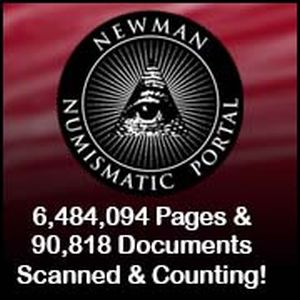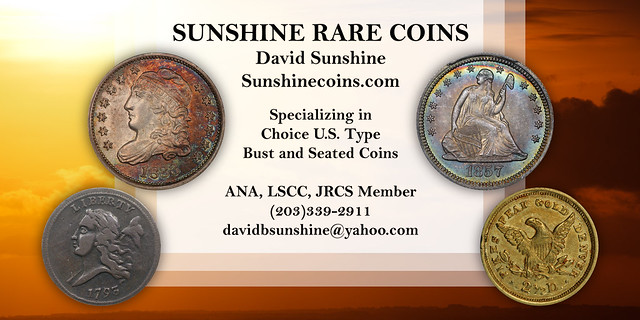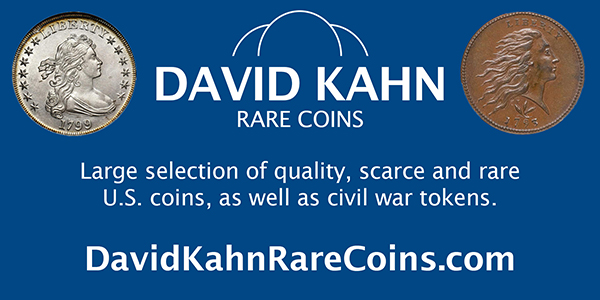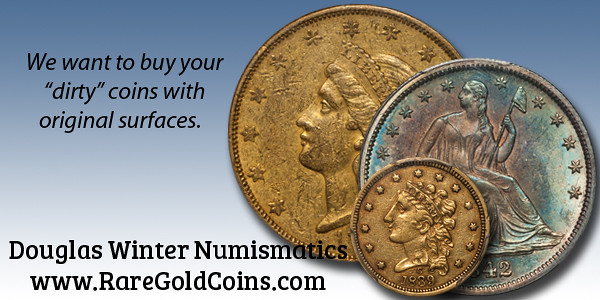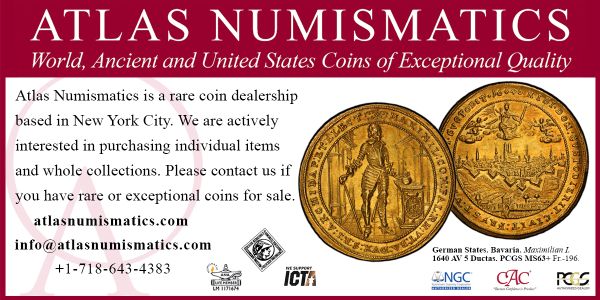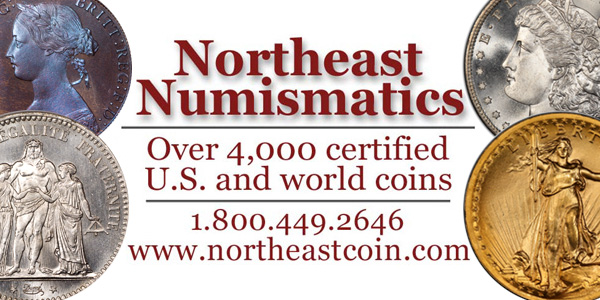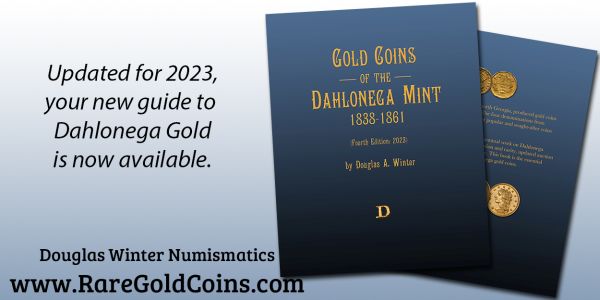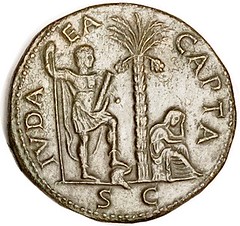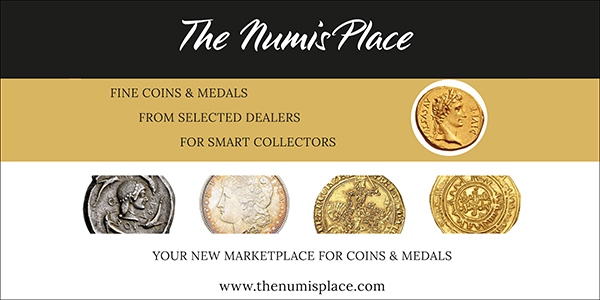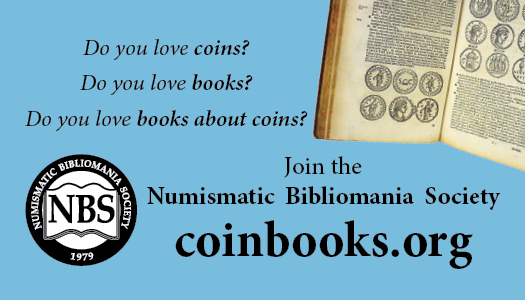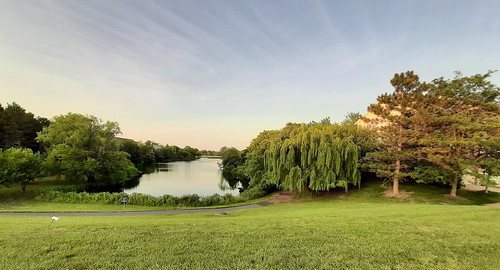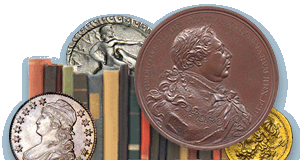
Visit our NBS Sponsors


About UsThe Numismatic Bibliomania Society is a non-profit association devoted to the study and enjoyment of numismatic literature. For more information please see our web site at coinbooks.org SubscriptionsThose wishing to become new E-Sylum subscribers (or wishing to Unsubscribe) can go to the following web page link MembershipThere is a membership application available on the web site Membership Application To join, print the application and return it with your check to the address printed on the application. Print/Digital membership is $40 to addresses in the U.S., and $60 elsewhere. A digital-only membership is available for $25. For those without web access, write to: Jeff Dickerson, Treasurer AsylumFor Asylum mailing address changes and other membership questions, contact Jeff at this email address: treasurer@coinbooks.org SubmissionsTo submit items for publication in The E-Sylum, write to the Editor at this address: whomren@gmail.com BUY THE BOOK BEFORE THE COINSale Calendar
|
- WAYNE'S WORDS: THE E-SYLUM JUNE 22, 2025
- NEW BOOK: BETTS MEDALS COMPANION (1747-1763)
- NEW BOOK: NORWEGIAN BANKNOTES
- JOHN WAYNE HIGHFILL (1943-2025)
- RONALD WAYNE LANDIS (1954-2025)
- THE THREE C4S
- VIDEO: AMERICA'S STATE QUARTERS
- MORE ON SOPHIA HOLMES
- NOTES FROM E-SYLUM READERS: JUNE 22, 2025
- THE COIN MAKEOVER AMERICA NEEDS
- VOCABULARY TERM: RIBBON
- EDNESS KIMBALL WILKINS (1896-1980)
- NUMISMATIC TREASURES AT OKLAHOMA ANA
- PHILIPPINE COLLECTORS FORUM AT OKLAHOMA ANA
- NUMISMAGRAM MEDAL SELECTIONS: JUNE 22, 2025
- ANCIENT COINS IN ROBINSON AUCTION 128
- HERITAGE JUNE 2025 U.S. ERROR COINS
- WAYNE'S NUMISMATIC DIARY: JUNE 22, 2025
- THE COINS OF SARDINIA
- DENMARK LETS AMATEURS DIG FOR TREASURE
- LOOSE CHANGE: JUNE 22, 2025
- FEATURED WEBSITE: NUMISMATICS INTERNATIONAL
- ABOUT THIS ISSUE: JUNE 22, 2025
Content presented in The E-Sylum is not necessarily researched or independently fact-checked, and views expressed do not necessarily represent those of the Numismatic Bibliomania Society.
WAYNE'S WORDS: THE E-SYLUM JUNE 22, 2025
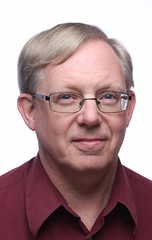 New subscribers this week include:
1715 Fleet Society members Michael Brown, Robert Kasicki and others, courtesy Ben Costello;
Welcome aboard! We now have 7,227 subscribers.
New subscribers this week include:
1715 Fleet Society members Michael Brown, Robert Kasicki and others, courtesy Ben Costello;
Welcome aboard! We now have 7,227 subscribers.
Thank you for reading The E-Sylum. If you enjoy it, please send me the email addresses of friends you think may enjoy it as well and I'll send them a subscription. Contact me at whomren@gmail.com anytime regarding your subscription, or questions, comments or suggestions about our content.
This week we open with two new books, two obituaries, updates from the Newman Numismatic Portal, notes from readers, and more.
Other topics this week include Betts medals, Norwegian banknotes, state quarters, Sophia Holmes, this year's ANA World's Fair of Money convention, fixed price and auction offerings, error coins, Denmark's metal detectorists, and Numismatics International.
To learn more about the Segovia and Gallery Mints, the Order of the Garter, lost and found coins, the Drummer Boy Quarter controversy, a colonial note signed by James Jarvis, medal ribbons, Edna's 1792 half dismes, the Philippine Collectors Forum, the ANA Presidential Award, aluminum, and the coinage of Sardinia, read on. Have a great week, everyone!
Wayne Homren
Editor, The E-Sylum
NEW BOOK: BETTS MEDALS COMPANION (1747-1763)
The Colonial Coin Collectors Club (C4) is excited to announce the release of its latest book on American Colonial numismatics, Medals of the Americas: The Betts Companion (1747–1763). -Garrett
Medals of the Americas: The Betts Companion (1747–1763)
By: Christopher R. McDowell
 The Colonial Coin Collectors Club (C4) is excited to announce the release of its latest book on American Colonial numismatics, Medals of the Americas: The Betts Companion (1747–1763) (C4, 2025). This fully illustrated, 445-page book is authored by Christopher R. McDowell, President of C4. McDowell, a prominent figure in the numismatic community, serves as a board member of the Medal Collectors of America, is a Fellow of the American Numismatic Society, a member of the Rittenhouse Society, and the long-time editor of the Journal of Early American Numismatics. He has written extensively on colonial numismatics.
The Colonial Coin Collectors Club (C4) is excited to announce the release of its latest book on American Colonial numismatics, Medals of the Americas: The Betts Companion (1747–1763) (C4, 2025). This fully illustrated, 445-page book is authored by Christopher R. McDowell, President of C4. McDowell, a prominent figure in the numismatic community, serves as a board member of the Medal Collectors of America, is a Fellow of the American Numismatic Society, a member of the Rittenhouse Society, and the long-time editor of the Journal of Early American Numismatics. He has written extensively on colonial numismatics.
This book, the second volume of a planned three-volume set, makes a significant contribution to understanding American colonial history. It fulfills Charles Wyllys Betts's ambition of illustrating this history through contemporary medals. This volume features Betts numbers 338 to 506, covering medals commemorating events from 1747 to 1763, including the French and Indian War. Notably, this volume thoroughly details Franco-American jetons and introduces a new taxonomy that encompasses the original medals issued by the Paris Mint in the designated years, along with all restrikes and copies of these jetons. Images and realized prices are provided for every Betts medal included, many of which are available for the first time. Additionally, the history of each medal is narrated, aiding in understanding its design and significance.
NEW BOOK: NORWEGIAN BANKNOTES
Here's an article from Geldscheine Online about a new book listing varieties of Norwegian banknotes. The article, originally written in German, was translated to English via ChatGPT. -Garrett
Norske Pengesedler (Norwegian Banknotes)
By: Karl Saethre, with contributions from Svein Atle Udjus and Terje Nygard
 26th Edition, 2022
26th Edition, 2022
490 pages with numerous illustrations
In Norwegian and English
Hardcover, fully in color
ISBN 978-82-92535-30-1
Price: 550 NOK (approx. EUR 48), plus shipping. Available for order, for example, from Skanfil (http://www.skanfil.no).
What "Grabowski" is for German paper money, the catalog by Karl Saethre is for Norway – the standard reference work for collectors of Norwegian banknotes.
This comprehensive, high-quality catalog is now available in its 26th, once again expanded, edition. Interest in Norwegian paper money is particularly strong among Norwegian collectors, as evidenced by recent auction results from Norwegian auction houses such as Skanfil, Roschberg, and Oslo Myntgalleri.
The issuance of paper money in Norway, which until 1814 was in a personal union with Denmark and governed from Copenhagen, began in August 1695 by the merchant Jørgen Thor Møhlen in Bergen. This venture ended in financial failure the following year. In 1713, banknotes were issued in Copenhagen by royal decree and circulated in Norway, but were declared worthless in 1717.
Further issues valid in Norway followed from 1737 onward.
JOHN WAYNE HIGHFILL (1943-2025)
Silver dollar expert and National Silver Dollar Roundtable founder John Highfill recently passed away at the age of 82. Here is the PNG obituary. He was born May 26, 1943 and died June 15, 2025. Photo credit: Donn Pearlman. -Garrett
 Tulsa, Oklahoma rare coin dealer John Highfill, founder of the National Silver Dollar Roundtable and author of a landmark 1,200-page reference book, The Comprehensive U.S. Silver Dollar Encyclopedia, passed away on June 15, 2025. He was 82.
Tulsa, Oklahoma rare coin dealer John Highfill, founder of the National Silver Dollar Roundtable and author of a landmark 1,200-page reference book, The Comprehensive U.S. Silver Dollar Encyclopedia, passed away on June 15, 2025. He was 82.
"My heart is broken, and I am leaning on the love and strength of those around me. I am so deeply grateful for the prayers and kind thoughts that already have been shared," wrote his wife, Marlene, in a message to friends and numismatic colleagues.
Highfill established the Oklahoma Coin Exchange in 1976. He founded the National Silver Dollar Round Table in 1982, became a member of the prestigious Professional Numismatists Guild (PNG) in 1986, and published his silver dollar reference book in 1992.
A 2019 story in the Greysheet newsletter stated: "John Highfill is known as a silver dollar guru."
"The PNG extends its heartfelt condolences to John's family and many friends. Throughout his long career, he always helped advance the hobby and was humble and kind to everyone," stated PNG Executive Director and Greysheet Publisher John Feigenbaum.
RONALD WAYNE LANDIS (1954-2025)
Ron Landis of the Gallery Mint has died. The prolific Eureka Springs AR musician, artist, engraver and minting expert was born March 25, 1954 and died June 17, 2025. -Editor
 On Facebook, Ron's longtime collaborator Timothy Grat
wrote:
On Facebook, Ron's longtime collaborator Timothy Grat
wrote:
"You may or may not know me, however it is my tearful duty to let everyone know that Ron Landis has left us and joined the Heavenly Chorus, likely in the musicians pit playing dobro or banjo!
"I will continue to post updates regarding any of his public affairs in the short term. If there are any specific needs or requests, I will be monitoring his Facebook Messenger as well as our email rlandis.studios@gmail.com.
"Ron's legacy will continue to thrive. As his instruments are played by the many folks he jammed with and loved as well as Landis Studios continuing to craft his inspired designs."
Below is an extensive overview of Ron's life and career from the Landis Studios website. -Editor
THE THREE C4S
The latest addition to the Newman Numismatic Portal is a run of the short-lived Coinquest Countermark Collectors' Circular, contributed by Dave Schenkman. Project Coordinator Len Augsburger provided this report and question. -Editor
The Three C4s
The "C4" acronym is popular in U.S. numismatics, with at least three associated entities. Most well known is the Colonial Coin Collectors Club, which publishes The C4 Newsletter, now in its 33rd year. The Carson City Collectors Club of America ("C4OA") held forth from 2005 to 2015, and, courtesy of David Schenkman, we recently scanned a run of the short-lived Coinquest Countermark Collectors' Circular, published by Carling Gresham from 1975-1976. The periodical aimed to unite countermark collectors and to promote associated research. Authors included Warren Lapp ("Counterstamps on U.S. Large Cents" in issue no. 2), David Schenkman ("More Countermark Pairs" in issue no. 5) and the authoritative Gregory Brunk, who contributed "A Tentative Countermark Bibliography" in no. 6.
The thought of only three C4s is oddly disruptive to our sense of bibliophilic and nomenclatural order. Surely an E-Sylum reader can identify a fourth?
VIDEO: AMERICA'S STATE QUARTERS
The David Lisot Video Library on the Newman Numismatic Portal can be found at:
https://nnp.wustl.edu/library/multimediadetail/522852
We highlight one of his videos each week in The E-Sylum. Here's one from 2009 with a panel speaking about America's State Quarter designs. -Editor
MORE ON SOPHIA HOLMES
Jerry Nashorn did some research and submitted this article on longtime Treasury Department employee Sophia Holmes, believed to be the first black woman employee of the U.S. government. Thank you! -Editor
 In response to Wayne's request about Sophia Holmes, I've found some additional information not included in the Brandimore article and at odds with it on key points concerning her employment history.
In response to Wayne's request about Sophia Holmes, I've found some additional information not included in the Brandimore article and at odds with it on key points concerning her employment history.
According to the article, in 1862. Mrs Holmes, a janitor working evenings at the Treasury Department, was rewarded by being made a messenger, a higher level job that paid more, when she turned in a large sum of money she had discovered to the Treasurer of the United States, General Francis Spinner. The article implies that she spent the next 30 plus years in that position before retiring in the late 1890s. This is not correct.
As will be shown below, after her encounter with Spinner, Mrs. Holmes was given a higher paid permanent job but as a laborer doing janitorial work. In 1866 or 1867, she was promoted to messenger. However, she was only in that position for several years before once again being classified and paid as a laborer, the position she held for the remainder of her career.
NOTES FROM E-SYLUM READERS: JUNE 22, 2025
Mystery Woman Studying Coins
Pete Smith writes:
 "Last week, The E-Sylum had a story "When Coins are Inherited." The article was illustrated
with a photo of a woman examining a coin collection. She was not identified.
Can any E-Sylum reader identify the woman or the coin she is holding? Send your response to
Wayne
before reading further. Spoiler Alert! The answers may appear elsewhere in this issue."
"Last week, The E-Sylum had a story "When Coins are Inherited." The article was illustrated
with a photo of a woman examining a coin collection. She was not identified.
Can any E-Sylum reader identify the woman or the coin she is holding? Send your response to
Wayne
before reading further. Spoiler Alert! The answers may appear elsewhere in this issue."
I can be reached at whomren@gmail.com. I knew the woman's name, but had guilty knowledge as editor of the article excerpt. But I hadn't thought about the coin and had no idea of what it was until I read Pete's excellent article. Check it out! -Editor
To read the earlier E-Sylum article, see:
WHEN COINS ARE INHERITED
(https://www.coinbooks.org/v28/esylum_v28n24a28.html)
Other topics this week include the Order of the Garter, German Inflation Notes, and Nelson Bunker Hunt. -Editor
THE COIN MAKEOVER AMERICA NEEDS
Jim Huntington published the following blog post about the U.S.'s current circulating coins. We're republishing it here with permission. -Garrett
I grew up in the 1960s. My allowance was nowhere near a dollar a week, and I had respect for all of it. I could spend a penny by itself – at a local toy store, it would buy a piece of candy. A dime would get me a small bag of that, or two small but ordinary Hershey's bars. A quarter, or at least 29 cents plus Chicago's 4% sales tax, would fetch my choice of several plastic toys. It was rare for me to have a dollar bill – I mostly only managed that at Christmas, or a few times when selling lemonade. The rest of the year the only money I handled was coins. A pocket full of them was a pocket full of possibilities.
Now it's 60 years later. Prices have risen roughly tenfold, but what we buy things with, except for effectively losing the half dollar and gaining the rarely-seen dollar coin, is the same. A pocketful of our coins is, to many, a nuisance, as even a quarter has less spending value than one cent did in the 1940s.
 Is this an appropriate situation? Our Department of Government Efficiency has recently said it is not. As a result, the current administration, per "Treasury Department to halt penny production after centuries in circulation" (Sophia Compton, Fox News, May 22nd), "is phasing out production for the penny," "made its final order of blank pennies this month and will stop putting one-cent coins into circulation by early 2026." Their cost apiece, since 2015, has moved from "a little over 1 cent to nearly 4 cents."
Is this an appropriate situation? Our Department of Government Efficiency has recently said it is not. As a result, the current administration, per "Treasury Department to halt penny production after centuries in circulation" (Sophia Compton, Fox News, May 22nd), "is phasing out production for the penny," "made its final order of blank pennies this month and will stop putting one-cent coins into circulation by early 2026." Their cost apiece, since 2015, has moved from "a little over 1 cent to nearly 4 cents."
VOCABULARY TERM: RIBBON
Here's another entry from Dick Johnson's Encyclopedia of Coin and Medal Terminology. I added a couple images. -Editor
Ribbon. The narrow cloth strips from which small medals are suspended. Medals of valor, military decorations, campaign medals, Olympic, some sports and educational awards, as well as others, have medallic items suspended from such cloth ribbons. The ribbons are a means of adding color, class, distinction, identification and substitution for such medallic awards in addition to providing a means for suspension for the medal to be worn.
An elaborate color code has evolved for American military medals, and this is true for England, France and nearly every country with military forces. Ribbons include other significance as well. The Victoria Cross, for example was bestowed to soldiers with red ribbon, for sailors, the ribbon was blue.
EDNESS KIMBALL WILKINS (1896-1980)
E-Sylum Feature Writer and American Numismatic Biographies author Pete Smith submitted this article on collector Edness Wilkins. Thanks! -Editor
 Edness Merrick Kimball was born in Casper, Wyoming, on January 31, 1896. She was the
daughter of Wilson S. Kimball, Sr. (1866-1952) and Edness Jane Merrick Kimball (1867-1912).
Her father had served as mayor of Casper for ten terms. The family was well-to-do with large oil
interests, ranching and a string of drug stores.
Edness Merrick Kimball was born in Casper, Wyoming, on January 31, 1896. She was the
daughter of Wilson S. Kimball, Sr. (1866-1952) and Edness Jane Merrick Kimball (1867-1912).
Her father had served as mayor of Casper for ten terms. The family was well-to-do with large oil
interests, ranching and a string of drug stores.
Edness Kimball graduated from Casper High School in 1914. She was class president and valedictorian. This was a girl with great potential.
She attended Ward-Belmont College in Nashville in 1914. Then she transferred to the University of Kentucky for the 1915-16 school year. In 1916, she was proclaimed as one of the four most popular and beautiful girls at the school. At school she was a reporter for the college newspaper. Back home in Casper, she was the society editor for the Natrona County Tribune. Later she attended the University of Nebraska, studying journalism.
NUMISMATIC TREASURES AT OKLAHOMA ANA
Many very important numismatic items will be displayed at the 2025 World's Fair of Money in Oklahoma City. -Garrett
Some of the most famous national numismatic treasures will be displayed for the first time in the Sooner State during the American Numismatic Association's 2025 Oklahoma World's Fair of Money (WorldsFairOfMoney.com) at the Oklahoma City Convention Center, August 19-23, 2025. ANA members are encouraged to pre-register for the show to skip the registration line. Pre-registration ends July 25.
"We are proud to display historic rare coins and bank notes for the first time in Oklahoma for the public to enjoy at our family-friendly, educational event," stated Thomas J. Uram, president of the 25,000-member American Numismatic Association (ANA). "This will be a chance for many people in the southwest to see these remarkable items in person."
PHILIPPINE COLLECTORS FORUM AT OKLAHOMA ANA
The Philippine Collectors Forum will hold its annual gathering at the ANA's World's Fair of Money on Friday, August 22, 2025, in Oklahoma City. Dennis Tucker will present a talk entitled, "Melecio Figueroa: The Saint-Gaudens of the Philippines." -Garrett
 The Philippine Collectors Forum will hold its annual gathering at the American Numismatic Association's summer convention (the World's Fair of Money) on Friday, August 22, 2025, in Oklahoma City. The PCF meeting is free and open to the public. Highlights include custom ANACS-slabbed commemorative coins for the first fifteen attendees, Philippine money–related door prizes, and 1940s Japanese Invasion currency from World War II. Educational features include a keynote lecture, market and auction reports, book reviews, and research updates from experts in the fields of Spanish and American Philippine coins, tokens, medals, and paper money.
The Philippine Collectors Forum will hold its annual gathering at the American Numismatic Association's summer convention (the World's Fair of Money) on Friday, August 22, 2025, in Oklahoma City. The PCF meeting is free and open to the public. Highlights include custom ANACS-slabbed commemorative coins for the first fifteen attendees, Philippine money–related door prizes, and 1940s Japanese Invasion currency from World War II. Educational features include a keynote lecture, market and auction reports, book reviews, and research updates from experts in the fields of Spanish and American Philippine coins, tokens, medals, and paper money.
"The field of U.S./Philippine currency has been very active in recent years," said PCF Secretary John Riley. "Not only are prices in the market rising, but researchers in the United States as well as the Philippines have been studying the historical record and publishing interesting new finds. Philippine coins have been newly featured in major hobby publications including the Greysheet and the Cherrypickers' Guide to Rare Die Varieties. Paper money, too, has seen a vibrant market and significant new publications in recent years. This is an exciting time to be a collector."
 Dr. Earl Honeycutt, coauthor with Sandy Lichauco of Philippine Medals and Tokens 1780–2024
(fourth edition, 2024), notes that it's not only coins that have seen fresh interest lately. The
market for Philippine tokens and medals has also blossomed. Ongoing research has added
hundreds of additional pieces to the latest edition of Honeycutt's groundbreaking book. "There
are opportunities for smart buyers as well as sellers," he said.
Dr. Earl Honeycutt, coauthor with Sandy Lichauco of Philippine Medals and Tokens 1780–2024
(fourth edition, 2024), notes that it's not only coins that have seen fresh interest lately. The
market for Philippine tokens and medals has also blossomed. Ongoing research has added
hundreds of additional pieces to the latest edition of Honeycutt's groundbreaking book. "There
are opportunities for smart buyers as well as sellers," he said.
The keynote speaker of the 2025 Philippine Collectors Forum is award-winning author Dennis Tucker, a Life Member of the Filipino American National Historical Society and former numismatic specialist on the U.S. Treasury Department's Citizens Coinage Advisory Committee. He will present a history and appreciation of Melecio Figueroa, the designer of the 1903–1945 Philippine coinage minted under American administration.
NUMISMAGRAM MEDAL SELECTIONS: JUNE 22, 2025
Numismagram's Jeremy Bostwick sent along these five medals from his most recent upload of new material to his site. For all of the new items, please visit https://www.numismagram.com/inventory. -Garrett
103212 | ITALY. Dionisio Ratta of Bologna cast bronze Medal. Dated 1592, and issued circa early-mid 17th century (66mm, 119.98 g, 11h). By Felice Antonio Casoni, fl. 1592-1634. + DIONYSIVS DE RATA VTR SIC REF ETS INQVISIT PRAELATVS CONS, cloaked bust right // DIVO / PETRO MARTVRI / TEMPLVM EREXIT / ET SEPVLCHRVM / SIBI CONSTRVXIT / SEDENTE / CLEMENTE VIII / PONT MAX / A D MDXCII (he erected the temple of Saint Peter, the martyr, and constructed his sepulcher, with the Pope Clemens VIII reigning in the year of the lord 1592) in nine lines. Edge: Some light marks as made, otherwise plain. Pollard 547 = Kress 476 (also holed at the top). Choice Extremely Fine. Warm red-brown surfaces, with some chasing on the higher points; pierced at the top. Ex Michael Hall Collection, part III (Baldwin's 67, 28 September 2010), lot 2292. $495.
Pollard, in Renaissance Medals, writes that "...Dionisio Ratta (d. 1597) of Bologna graduated from Bologna University on 19 March 1572 and became one of the Giudici di Collegio in that year. He held various offices in Rome, such as auditor of the Rota, a sacred court of the Catholic Church. The reverse inscription records the construction of the Church of Saint Peter Martyr in Bologna and the erection of Ratta's tomb. The foundation stone was laid in 1592. Dolfi noted that medals of Ratta were placed in the church's foundations." About the artist of this medal, Felice Antonio Casoni, he writes that "...Casoni was born in Ancona and died in Rome. He was trained in Bologna and was employed there as early as 1592. Casoni is recorded as the architect of conventional buildings in Rome and as a sculptor, wax modeler, and medalist. Six medals are attributed to him, four of which are dated 1592."
ANCIENT COINS IN ROBINSON AUCTION 128
Dealer Frank S. Robinson's 128th mail and internet auction of Ancient and Early Coins will include 581 lots, low starting bids, and no buyer fee. LIVE BIDDING will take place beginning at 11 AM Eastern Time July 13 on the biddr.com website. (The deadline for pre-bidding will be July 12.) -Garrett
Featured in this sale is a further segment of a major collection of Judaean and Judaic related material, highlighted by Choice EF Vespasian "Judaea Capta" Sestertius, of an apparently unpublished variety.
Greek coins include a slabbed EF Armenian Tigranes II Tetradrachm; a classic Athenian "Owl" tetradrachm in choice quality; VF Baktrian Tetradrachm of Eukratides I with heroic bust type; and an excellent run of Parthian coins.
THE BOOK BAZARRE
HERITAGE JUNE 2025 U.S. ERROR COINS
Heritage Auctions will be hosting their U.S. Coins Error Showcase on June 23. Select items from the Curators' Picks are discussed below. -Garrett
1826 1/2 C Classic Head Half Cent, C-1, B-1, R.1 -- Struck 10% Off-Center -- VF35 PCGS. Early type coins and early copper with Mint errors are scarce in the context of Mint errors. I get excited when I see one, especially if the coin is problem-free from an impairment and grade perspective. This Choice VF 1826 Classic Head half cent is such a coin. The 10% off center strike is enough to be visually interesting while not being overly dramatic or impacting the aesthetic of the design. The coin also has smooth brown surfaces and generally good eye appeal. Definitely one of the highlights of the auction in my view.
WAYNE'S NUMISMATIC DIARY: JUNE 22, 2025
Tuesday June 17, 2025 was the meeting night of my Northern Virginia numismatic social group Nummis Nova. Jon Radel and John Kraljevich (who was unable to attend due to work commitments) chose the Sorn Thai restaurant in Mclean. Traffic was good for a change and I arrived early, but not early enough to beat other members to the bar; they included Dave Schenkman, Eric Schena, Daryl Haynor, Tom Kays and Jon. I ordered a glass of wine and had a nice conversation with Dave and Eric before we all headed over to our table.
Soon my guest Jonathan Brecher of the Boston area joined us and sat across the table from me. Then Julian Leidman and Steve Bishop filled in the nearby seats. Others present included Mike Packard and Mike Markowitz.
THE COINS OF SARDINIA
Steve Benner wrote an article in CoinWeek on the coinage of Sardinia. Here's an excerpt - see the complete article online. -Garrett
When I began researching this article, I was aware of Sardinia's rich 8,000-year history, but I hadn't realized how limited the information on its coinage was. I've compiled all the available material to write this article, and I hope readers find it enlightening.
Sardinia, the second-largest island in the Mediterranean after Sicily, lies approximately 120 miles (200 km) off Italy's west coast, north of Tunisia. It covers an area of 24,100 km² (9,305 sq mi). To its west is the Sea of Sardinia (part of the Mediterranean Sea), and to its east is the Tyrrhenian Sea. To the north, the island of Corsica is separated by the Strait of Bonifacio (Fretum Gallicum). Sardinia is a predominantly mountainous island with a generally high and rocky coastline featuring numerous small islands. Its highest peak, Punta La Marmora, stands at 6,017 feet in the island's center. The mountain ranges are interspersed with wide alluvial valleys and flatlands in the southwest and northeast. The island is divided by a few major rivers, including the Tirso, Coghinas, and Flumendosa. Most of the arable land was historically used for growing cereals and fruit.
Punic Coins
Carthage began minting bronze coins on Sardinia in the late 4th century BCE, shortly before the First Punic War. The precise location of these mints remains unknown, though Caralis—the island's largest city and an early Carthaginian conquest—is the most probable site. Tharros presents another strong possibility.
Figure 2 displays two bronze coins, chosen for their historical significance. The first (Figure 2a) is among the oldest coins minted in Sardinia, while the second (Figure 2b) was produced during the First Punic War (264–241 BCE).
Coin 2a features Tanit on the obverse and a horse's head on the reverse, accompanied by a palm tree and a pellet. Tanit, Carthage's principal goddess, was revered as a mother goddess, goddess of fertility, and sky goddess. The horse's head could symbolize Carthage's formidable cavalry and military might. Alternatively, it might allude to the myth of Dido's companions discovering a horse's head at the site Juno designated for Carthage's founding. A third explanation is that "KAKKABH"—Punic for "horse's head"—was an ancient name for Carthage. This design was the most prevalent type of Carthaginian coin.
Coin 2b also depicts Tanit on the obverse, with a standing horse on the reverse, a pellet, and the Punic letter "G." This letter may represent a magistrate or minter. Both coins exhibit excellent artistry, particularly Coin 2a.

Figure 2: CARTHAGE. Sardinia mint. A) Circa 300-264 BCE, AE Shekel(?), 20mm, 5.49 g. Wreathed head of Tanit left / Head of horse right; palm tree to right, pellet below SNG Copenhagen 175; b) 1st Punic War, Circa 264-261 BCE, AE 23mm, 8.07 g. Wreathed head of Tanit left / Horse standing right, pellet below, Punic letter G before. SNG Copenhagen 205.
DENMARK LETS AMATEURS DIG FOR TREASURE
Denmark has a growing program similar to Britain's Treasure Trove law, prompting metal detectorists to search for artifacts. There's only one numismatic illustration in this article, but it's an interesting read. Here's an excerpt - see the complete article online. -Editor
 Ole Ginnerup Schytz, an engineer in Denmark's sleepy Vindelev agricultural area, had used a metal detector only a handful of times when he found a bent clump of metal in a friend's barley field... Ginnerup dug up 14 glittering gold disks—some as big as saucers—that archaeologists say were buried about 1,500 years ago, during a time of chaos after ash clouds from a distant volcanic eruption created a miniature ice age. Four medallions feature Roman emperors, and several bear intricate geometric patterns. But the real showstopper is an amulet called a bracteate with two stylized designs: a man in profile, his long hair pulled back in a braid, and a horse in full gallop. An expert in ancient runes says she was awestruck when she finally made out the inscription on top: "He is Odin's man."
Ole Ginnerup Schytz, an engineer in Denmark's sleepy Vindelev agricultural area, had used a metal detector only a handful of times when he found a bent clump of metal in a friend's barley field... Ginnerup dug up 14 glittering gold disks—some as big as saucers—that archaeologists say were buried about 1,500 years ago, during a time of chaos after ash clouds from a distant volcanic eruption created a miniature ice age. Four medallions feature Roman emperors, and several bear intricate geometric patterns. But the real showstopper is an amulet called a bracteate with two stylized designs: a man in profile, his long hair pulled back in a braid, and a horse in full gallop. An expert in ancient runes says she was awestruck when she finally made out the inscription on top: "He is Odin's man."
These embossed runes are the oldest known written mention of Odin, the Norse god of war and ruler of Valhalla. Ginnerup's bracteate, which archaeologists describe as the most significant Danish find in centuries, extended the worship of Odin back 150 years—and it's all because Ginnerup received a metal detector as a birthday present from his father-in-law.
LOOSE CHANGE: JUNE 22, 2025
Here are some additional items in the media this week that may be of interest. -Editor
A Numismatic News article by Rich Giedroyc discusses mint errors and "wannabe" mint errors. Here's an excerpt - see the complete article online. This first one sounds fishy to me. -Editor
I have seen many people on selling sites selling Washington quarters with an "In COD We Trust" error. Is this a true error or a design change?
There are production errors and die errors. Production errors may involve a foreign object, likely grease, momentarily blocking part of a design element on a single coin. Die errors occur when something is wrong or altered on an individual die. This also results in multiple coins with the same situation. Die errors are more valuable than production error coins. Regardless, do not buy such a coin unless it has been certified by a well-known third-party certification service.
Is it possible the mint used a die on which the word God was misspelled as Cod?
The Numismatic Guaranty Corporation website published well-known coin dealer Jeff Garrett's article "Fake News and Misinformation in Numismatics." In the article, Garrett says, "These widespread falsehoods include claims that coins that have minor anomalies, were damaged or altered after being struck, or are even perfectly normal coins are valuable ‘mint errors.' In the case of American Women quarters, all of them appear to have a G in the motto that, at a cursory view, could be taken for a C." In other words, buyer beware.
To read the complete article, see:
CoinClinic: Manufacture Errors Have Modest Value
(https://www.numismaticnews.net/coinclinic-manufacture-errors-have-modest-value)
Other topics this week include a 1684 Charles II Five Guinea. -Editor
FEATURED WEBSITE: NUMISMATICS INTERNATIONAL
This week's Featured Website is Numismatics International.
Numismatics International (NI) was established in April 1964 and has members located worldwide. NI is the largest and most active numismatic organization in the world which excludes the sale, trade, discussion or display of coins and currency of the United States of America. This allows a focus to study and collect other countries and regions in the world.
The Objectives of Numismatics International are to:
- Encourage and promote the science of numismatics by specializing in areas and nations other than the United States of America;
- Cultivate fraternal relations among collectors and numismatic students;
- Encourage and assist new collectors;
- Foster the interest of youth in numismatics;
- Stimulate and advance affiliations among collectors and kindred organizations;
- Acquire, share and disseminate numismatic knowledge.
http://numis.org/
ABOUT THIS ISSUE: JUNE 22, 2025
Outside of a great Nummis Nova dinner, the week was a quiet one numismatically. I'd been planning to go up to the Whitman Baltimore show on Thursday, but I had some dental surgery in the morning and decided to stay home instead. I'd already spent hours in traffic the day before in a horrible downpour where 3 or 4 inches of water pooled on the Capitol Beltway. Another storm was forecast and arrived forcefully in the late afternoon, knocking our power out for 45 minutes before dinner. Sorry to miss everyone at the show, but staying away was a good decision.
Friday and the weekend were beautiful, hot and sunny days. After going out to dinner with my family Saturday and working on The E-Sylum for a while, I decided to go out for another walk. I'd been gradually lengthening my walks and this time I decided to try the path around a nearby lake. I've been living here since 2006 and hadn't realized that there were two more lakes behind that one. So I kept walking and walking, making it back home not long before sundown. Very peaceful - I'll be taking that route again. 14,632 steps on my pedometer Saturday, a new record for this year. Here are some photos. -Editor

